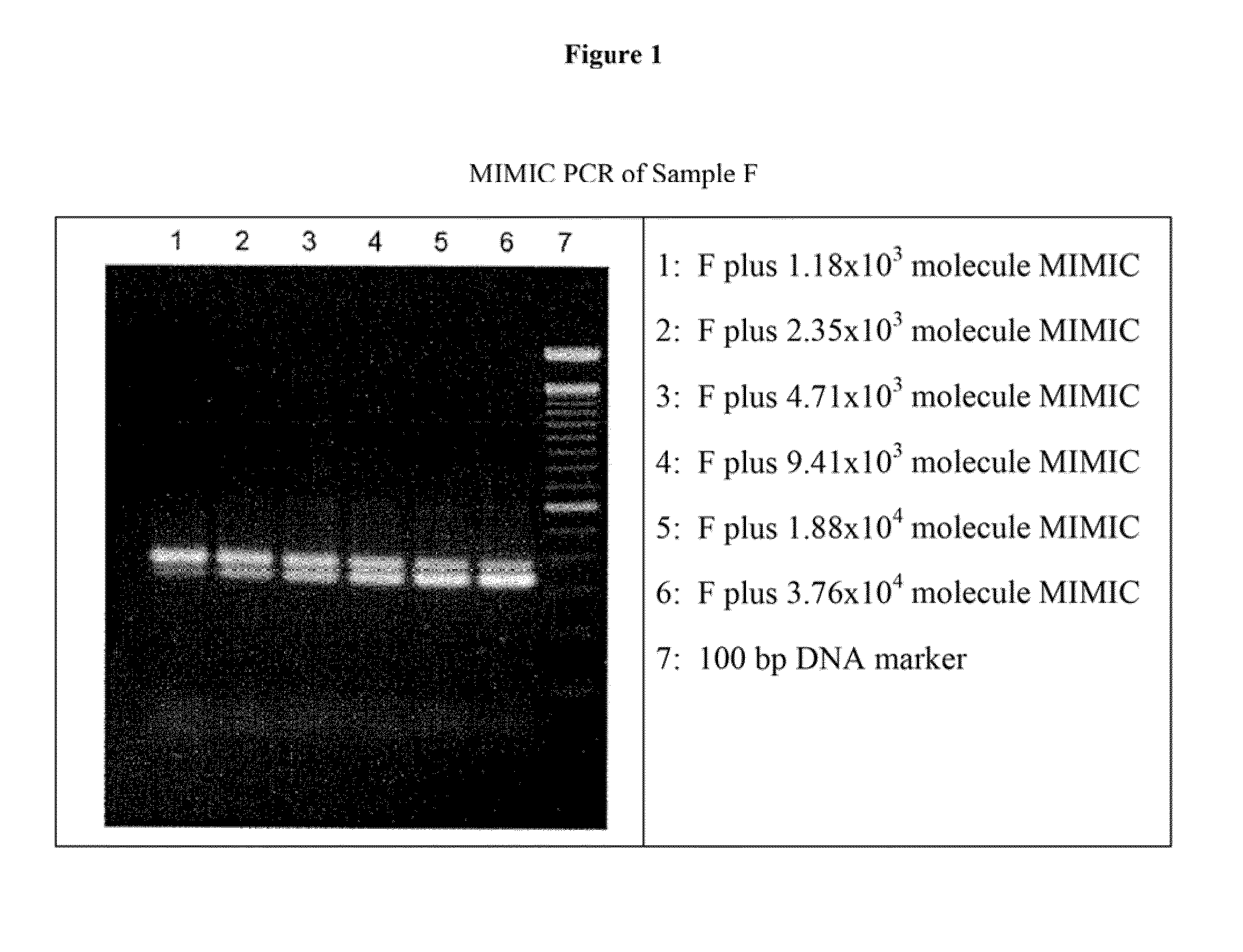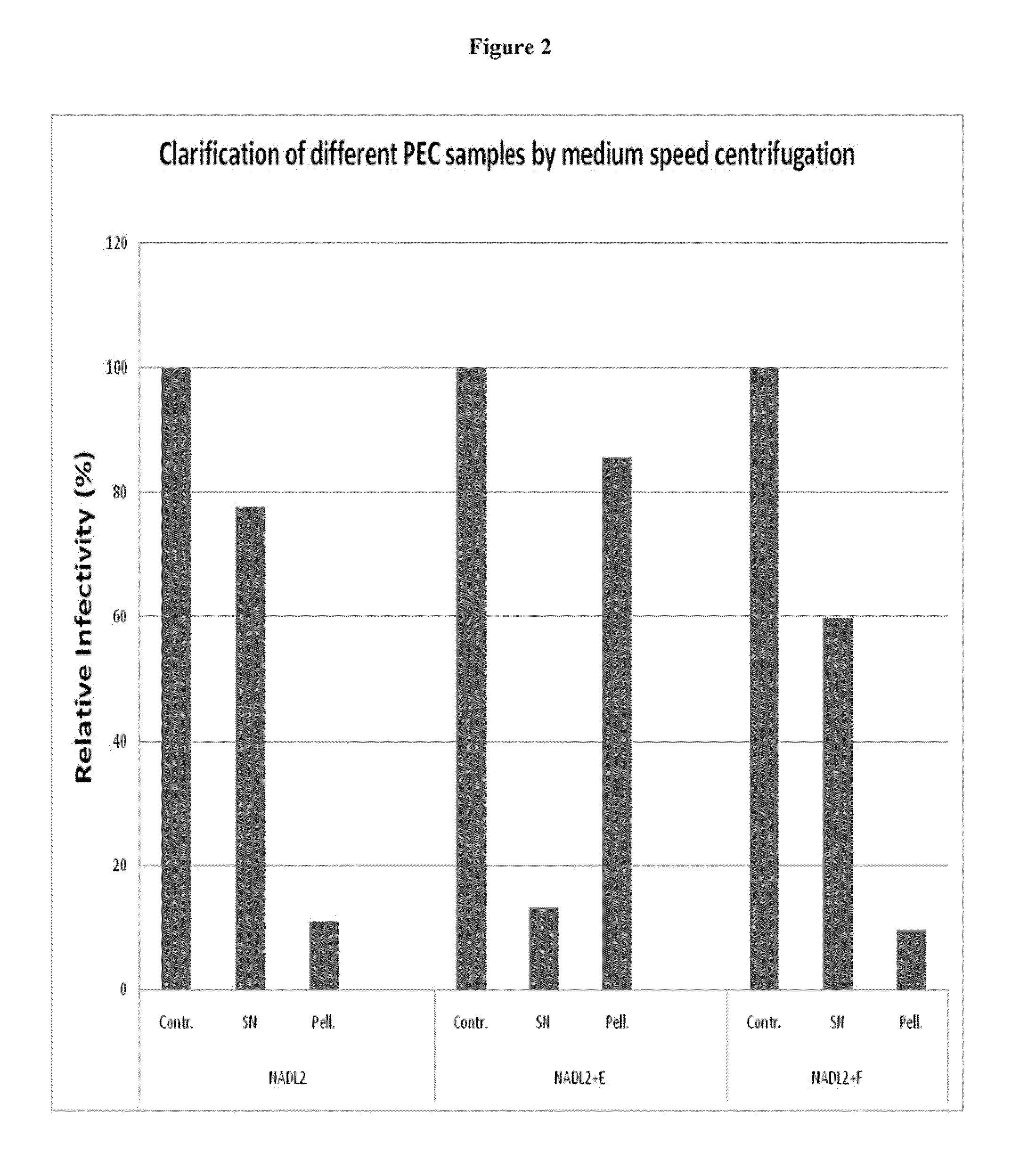Method for detecting infectious parvovirus in pharmaceutical preparations
- Summary
- Abstract
- Description
- Claims
- Application Information
AI Technical Summary
Benefits of technology
Problems solved by technology
Method used
Image
Examples
example 1
Initial Sample Treatments and PCR Standardizations
[0068]A. Sample Materials
[0069]All of the tested samples were packaged in their appropriate medical dosage forms. For experiments, aliquots of these samples were suspended at a concentration of 100 mg dry content per ml, in a specific buffer (100 mM Tris / HCl, pH=8.5). During this study, six different products were used for analysis as indicated on Table 1 and listed below as samples A-F.
[0070]Samples
[0071]A: Pellets
[0072]B: Pellets
[0073]C: pellets,
[0074]D: powder
[0075]E: tablet
[0076]F: minitablets
1. Handling of Sample Materials
[0077]Vials with the original material were stored at room temperature. Before experiments, aliquots of the samples were suspended at a concentration of 100 mg dry content per mL in a specific buffer (100 mM Tris / HCl, pH=8.5). Suspended samples were kept at room temperature for overnight and later they were stored at 4° C.
[0078]B. Methods and Reaction Materials
[0079]MIMIC PCR protocol, performed according to ma...
example 2
Two-Step PEG Precipitations
[0113]Polyethylene glycols (PEG) with different molecular weight (PEG3400, PEG8000 and PEG20000) were used to test the virus precipitation. PEG 8000 gave the best result because there was no detectable virus either in the first or in the second upper phase. PEG 3400 and PEG 20000 were less effective, since in their upper phase virus DNA could be detected by PCR.
[0114]In each case 1 mL 20% PEG, 300 mM NaCl, 100 mM Tris / HCl pH=8 was mixed with 1 mL of the sample (100 mg / mL). All samples were incubated on ice for 1 hour and centrifuged at 14,000 g for 5 min. The supernatant was removed and the pellet was dissolved in 1 mL 100 mM Tris / HCl, pH=8. An 100 μL aliquot of the resolved pellet was stored for DNA preparation and the remaining 900 μL was reprecipitated with 900 μL PEG solution (20% PEG, 300 mM NaCl, 100 mM Tris / HCl pH=8) incubated on ice for 1 hour and centrifuged at 14,000 g for 5 min. The supernatant was again removed and the pellet was dissolved in 9...
example 3
Three-Step Precipitations
[0115]A three-step precipitations were also performed, for these reactions, 1 mL of sample was first incubated on ice with 200 μL ammonium sulfate ((NH4)2SO4) for 1 hour and then centrifuged at 14,000 g 5 min. The supernatant was removed and the pellet was dissolved in 1 mL 100 mM Tris / HCl pH=8. Next, a 900 μL aliquot of the ammonium sulfate supernatant was reprecipitated with 900 μL PEG solution, incubated on ice for 1 hour and centrifuged at 14,000 g (5 min). The supernatant was removed and the pellet was dissolved in 750 μL 100 mM Tris / HCl pH=8. In the third step, a 100 μL aliquot of the dissolved pellet was taken for DNA preparation and the remaining 650 μL was reprecipitated with 650 μL PEG solution, incubated on ice for 1 hour and centrifuged at 14,000 g for 5 min. The supernatant was then removed and the pellet was redissolved in 650 μL 100 mM Tris / HCl pH=8.
[0116]The (NH4)2SO4 precipitation resulted in a thick pellet, which contained detectable amount...
PUM
| Property | Measurement | Unit |
|---|---|---|
| Time | aaaaa | aaaaa |
| Time | aaaaa | aaaaa |
| Fraction | aaaaa | aaaaa |
Abstract
Description
Claims
Application Information
 Login to View More
Login to View More - R&D
- Intellectual Property
- Life Sciences
- Materials
- Tech Scout
- Unparalleled Data Quality
- Higher Quality Content
- 60% Fewer Hallucinations
Browse by: Latest US Patents, China's latest patents, Technical Efficacy Thesaurus, Application Domain, Technology Topic, Popular Technical Reports.
© 2025 PatSnap. All rights reserved.Legal|Privacy policy|Modern Slavery Act Transparency Statement|Sitemap|About US| Contact US: help@patsnap.com


